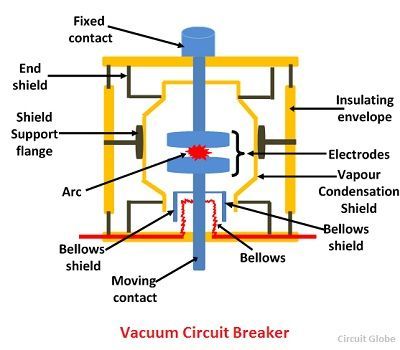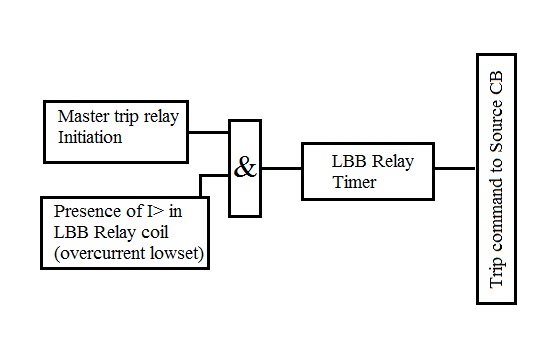Circuit Breaker
Can you imagine a world where there is no control of the electric supply? As mentioned, electric power is the most dangerous form of energy in the world. So it is clear that if not controlled, results in the destruction of many thing, example human life, animal life, equipments, etc.

So to control the electric power, we developed these equipments such ass isolators ans circuit breakers. Automated control of electric power with pre-set values are done by Circuit Breakers[CB].
It was in 1879, the idea for a circuit breaker was developed by Thomas Alva Edison. A circuit breaker disconnect an electric circuit by simply opening a contact, when the monitoring system gives the trip signal. Now-a-days this monitoring systems are known as relay. Household circuit breakers are inbuilt with this mechanism.
The circuit breaker is an absolutely essential device in the modern world, and one of the most important safety mechanisms in your home as well as in industries. Whenever electrical wiring in a building has too much current flowing through it, these simple machines cut the power until somebody can fix the problem.
We know, when high voltage rating lines are disconnected from the bus and electric arc (heat energy) is formed between the gap. It is common and dangerous. So to control these, we need other features installed in circuit breaker. Boston Electric Light Company in 1898 used first circuit breaker featuring and oil tank and upward-breaking contacts which are manually operated. The oil was used to suppress the heat generated by the electric arc formed between the open contacts.
There are different types of circuit breakers depending on the heat suppressing (arc quenching) medium used. They are;
1. Air circuit breaker are those device which protect electrical equipments rated below 450 voltage. It provides overcurrent and short circuit protection for electric circuit over 800A to 10kA. Here arc quenching medium is air. The moving and fixed contacts are arranged in a chamber having ventilation. So air can travel inside out when the contact are detached, the arc formed is suppressed using arc splitters(chamber). Sectional view is given in the figure below. Moving contact is charged with spring. This spring gives the power to close and open the contacts.

2. Air blast circuit breaker used compressed air or gas as the arc interrupting medium. In the air blast, circuit breaker compressed air is stored in a tank and released through a nozzle to produce a high-velocity jet; this is used to extinguish the arc. Air blast circuit breakers are used for indoor services in the medium high voltage field and medium rupturing capacity. Generally up to voltages of 15 KV and rupturing capacities of 2500 MVA. The air blast circuit breaker is now employed in high voltage circuits in the outdoors switch yard for 220 KV lines.Though gasses such as carbon dioxide, nitrogen, freon or hydrogen are used as the arc interrupting medium, compressed air is the accepted circuit breaking medium for gas blast circuit breakers.
3. In oil circuit breakers, some insulating oil (e.g., transformer oil) is used as an arc quenching medium.When the contacts of the oil circuit breaker are opened under oil and an arc is struck between them. The heat of the arc evaporates the surrounding oil and dissociates it into a substantial volume of gaseous hydrogen at high pressure.
 The hydrogen gas occupies a volume about one thousand times that of the oil decomposed. The oil is, therefore, pushed away from the arc and an expanding hydrogen gas bubble surrounds the arc region and adjacent portions of the contacts.
The hydrogen gas occupies a volume about one thousand times that of the oil decomposed. The oil is, therefore, pushed away from the arc and an expanding hydrogen gas bubble surrounds the arc region and adjacent portions of the contacts.
The arc extinction is facilitated mainly by two processes.
a. Firstly, the hydrogen gas has high heat conductivity and cools the arc, thus aiding the de-ionisation of the medium between the contacts.
b. Secondly, the gas sets up turbulence in the oil and forces it into the space between contacts, thus eliminating the arcing products from the arc path.
The result is that arc is extinguished and circuit current interrupted.
4. In Vacuum circuit breaker, the fixed and moving contact is enclosed in a permanently sealed vacuum interrupter. The arc is extinct as the contacts are separated in high vacuum. It is mainly used for medium voltage ranging from 11 KV to 33 KV. Vacuum circuit breaker has a high insulating medium for arc extinction as compared to the other circuit breaker. The pressure inside the vacuum interrupter is approximately 10-4 torrent and at this pressure, very few molecules are present in the interrupter. The vacuum circuit breaker has mainly two phenomenal properties.
 a. High insulating strength: In comparison to various other insulating media used in circuit breaker vacuum is a superior dielectric medium. It is better than all other media except air and SF6, which are employed at high pressure.
a. High insulating strength: In comparison to various other insulating media used in circuit breaker vacuum is a superior dielectric medium. It is better than all other media except air and SF6, which are employed at high pressure.
b. When an arc is opened by moving apart the contacts in a vacuum, an interruption occurs at the first current zero. With the arc interruption, their dielectric strength increases up to a rate of thousands time as compared to other breakers.
The above two properties make the breakers more efficient, less bulky and cheaper in cost. Their service life is also much greater than any other circuit breaker, and almost no maintenance are required.

5. In SF6 Circuit breaker, sulphur hexafluoride gas is used as the arc quenching medium.
sulphur hexafluoride gas (SF6) is an electronegative gas and has a strong tendency to absorb free electrons. The contacts of the breaker are opened in a high-pressure flow sulphur hexafluoride (SF6)gas and an arc is struck between them. The gas captures the conducting free electrons in the arc to form relatively immobile negative ions. This loss of conducting electrons in the arc quickly builds up enough insulation strength to extinguish the arc. The sulphur hexafluoride (SF6) circuit breakers have been found to be very effective for high power and high voltage service.A sulphur hexafluoride (SF6) circuit breaker consists of fixed and moving contacts enclosed in a chamber. The chamber is called arc interruption chamber which contains the sulphur hexafluoride (SF6) gas. This chamber is connected to sulphur hexafluoride (SF6) gas reservoir. A valve mechanism is there to permit the gas to the arc interruption chamber. When the contacts of breaker are opened, the valve mechanism permits a high-pressure sulphur hexafluoride (SF6) gas from the reservoir to flow towards the arc interruption chamber.
The fixed contact is a hollow cylindrical current carrying contact fitted with an arcing horn. The moving contact is also a hollow cylinder with rectangular holes in the sides. The holes permit the sulphur hexafluoride gas (SF6) gas to let out through them after flowing along and across the arc. The tips of fixed contact, moving contact and arcing horn are coated with a copper-tungsten arc-resistant material. Since sulphur hexafluoride gas (SF6) gas is costly, it is reconditioned and reclaimed using the suitable auxiliary system after each operation of the breaker.




Comments
Post a Comment